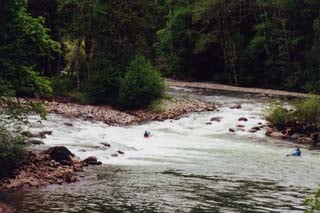
A bright future for MF Snoqualmie (WA) access
The Middle Fork of the Snoqualmie River is one of the more significant outdoor recreation areas, "close-to-home" for residents of the greater Seattle area. Less than an hour drive from downtown, the valley is easily accessible to a population of over three million people and a destination for visitors from around the country. Despite its proximity to a large metropolitan area, the river feels remote as it winds through a forested river valley largely held in public ownership and it has been proposed for designation as a Wild and Scenic River by the U.S. Forest Service. While a diversity of recreational opportunities can be pursued within the boundaries of the watershed, the river itself is known as one of the region's finest whitewater resources. With over 40 miles of whitewater, the river and its tributaries serve a wide range of skill levels with some sections suitable for beginner instruction, others that challenge the nation's top experts, and everything in between.
The most popular sections include the Middle-Middle, the closest intermediate whitewater to Seattle and a popular after-work run; the Club Stretch, an excellent beginner training ground popular for instruction; and the Upper Middle, one of the most scenic class II runs in the state. In addition to these runs there are several other sections some of which provide challenging wilderness kayaking experiences and others that define the limits of extreme creeking. These include the Upper Upper Middle, Dingford Creek, Pratt River, Taylor River, and Wildcat Section.
Despite the quality of this river as a recreational resource, formal public access has never been provided. Several decades ago when the first paddlers began to regularly boat the Middle Fork Snoqualmie access wasn't much of an issue, but as development pressure increased along the river opportunities for public access began to vanish. Those with kayaks now scramble down the bank at a few informal access points. Paddlers, particularly those with larger and more cumbersome boats such as canoes and rafts, lost convenient access at the Concrete Bridge with the construction of a berm that blocked the popular access trail. Just downstream the State DNR's Mine Creek Campground was closed when vandalism increased to a point that public safety was compromised and with this the convenient access to Island Drop was gated. Access at Tanner Road has also become more of a challenge as new homes blocked a convenient landing at the end of the road and pressed paddlers into a narrow strip of land in a residential neighborhood. The good news is after more than a decade of effort, a plan to address these issues was finally developed in 1997.
That year, a vision plan for the Middle Fork Snoqualmie was released through a regional partnership between the US Forest Service, State DNR, State Parks, King County, North Bend, and numerous local user groups including boating, equestrian, hiking, biking, hunting and fishing interests. In all over 25 groups were at the table. The Middle Fork Plan highlighted several strategic improvements that could be made to dramatically improve public safety and public access within the watershed of the Middle Fork Snoqualmie. Of interest to whitewater paddlers, the plan called for formal river access at several sites including Concrete Bridge, Island Drop, and near Tanner Road. King County then began the process of acquiring the property that could make implementation of the plan a reality. The parcel downstream river left of Concrete Bridge (aka as Granite Creek Flats), where the historic river access trail was located, was purchased through the Waterways 2000 program. Purchase of a parcel near Tanner Road proved to be more of a challenge, but King County worked closely with regional paddling clubs in developing a successful IAC grant proposal to acquire funds to purchase a 50 acre site approximately half a mile downstream of the existing access of Tanner Road. This site is unique as one of the only undeveloped sections of low-bank beach access. By early 2003 King County was successful in bringing this property into public ownership.
An opportunity now exists to develop and implement an access and management plan for these sites. Earlier this spring AW's Executive Director Risa Shimoda and Access Director Jason Robertson both participated in site visits with local volunteers, and in May of this year Jason joined with representatives from Washington Kayak Club, University Kayak Club, PaddleTrails, Mountaineers, and Washington Recreational River Runners in meeting with staff from King County Parks. At that meeting parks staff introduced a new program called the Association Development and Operation Partnerships (ADOP) Program. King County announced this program as a way to meet the public need for enhanced park facilities in a time of budget cuts. Through this program, non-profits can enter into a formal partnership agreement with King County Parks, that in turn provides a mechanism for the creation of new and enhanced facilities on land already owned by King County. King County provides the land while the partnering non-profit provides their volunteer resources, expertise, and revenue generating potential to develop and manage the site in a manner consistent with public needs. The partner organization is thus given the opportunity to develop a concept plan and long-term maintenance plan for a site of interest to its membership.
AW and local affiliate clubs are currently working with King County in developing an ADOP partnership. We have also submitted a proposal to the National Park Service's Rivers, Trails, and Conservation Assistance program to assist us in developing site plans. We are currently soliciting input from the local paddling community and interested local partners. If you have an interest in participating please contact Washington Regional Coordinator Tom O'Keefe or Access Director Jason Robertson.
Download a complete copy of the River Corridor Public Use Concept and AW's proposal to the NPS RTCA program.
